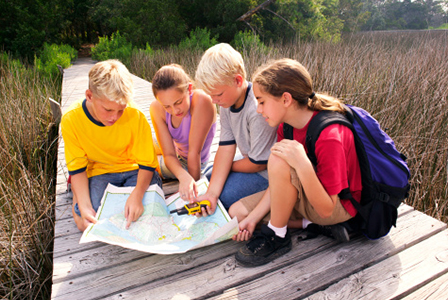
Cabin fever has set in on most families across the country. We have had an unusually long and colder than usual winter that was felt well into the South. Everyone is ready to get active and get back outdoors.
geocaching Homeschool fun
With spring just around the corner, geocaching might be the perfect activity to incorporate some outdoor lessons in your lesson plans. Geocaching is a great way to cover multiple homeschool lessons while having fun.
What is geocaching
Geocaching (pronounced GEE-o-cash-ing) offers children a fun and safe way to learn about the wonders of the outdoors. Geocaching is a modern day, worldwide, family-friendly treasure hunt. Participants go on a journey to find small containers called geocaches. Seekers can visit a site like Geocaching.com to search for caches hidden in their area. Geocaches can contain a variety of objects that people have left, such as pens, notes, toys, handmade items, stationery or anything you can leave inside the geocache for the next person to find. There is a general rule that if you take something from the geocache, you must leave something.
How to incorporate geocaching into your homeschool
Geocaching can be used in a variety of ways to supplement your homeschool lessons. Geocaching encourages children to explore their surroundings while using critical thinking skills to find the cache.
Math and mapping skills
This is a fun hands-on activity to learn latitude and longitude. Use GPS, as well as a compass, to find locations locally and around the world via Geocaching.com. Follow GPS coordinates to find the items to measure, then figure out the average.They can learn fractions with these free geocache fraction worksheets.
Safety

Show your children how to be safe in the woods, as well as how to survive should they got lost in the woods.
Physical education
Once you have found areas with hidden geocaches, the hiking begins. Map out your path and take a long walk to find your geocaches, a great way to get in some exercise.
Art
Make items to put into the geocaches once you have found and emptied them. It's always good to put something back in for the next person to find when you have taken something out.
Unit studies
You can create your own unit studies incorporating vocabulary, math, science, history and art within the items you choose to put into your caches. Whether it be old coins from another country or objects from other countries that you create.
Science
Have children keep a journal to take note of their surroundings or what they find. The best way to learn is to talk and walk; ask open-ended questions about objects or seek out science lessons with your five senses. Teach earth science with this free 90-page educator's guide.
Last, but certainly not least, you can search for your very own Travel Bug. A Travel Bug is a trackable tag that you attach to an item that moves from place-to-place, picking up stories along the way. You can add your own story or live vicariously through each Bug's adventures.
![]() Tell Us:
Tell Us:
Have you tried geocaching? How have you incorporated geocaching into your homeschool lessons?
More on geocaching
Modern-day treasure hunting: A guide to geocaching
Go on a treasure hunt: A geocaching primer
6 Fun fall homeschool activities
















